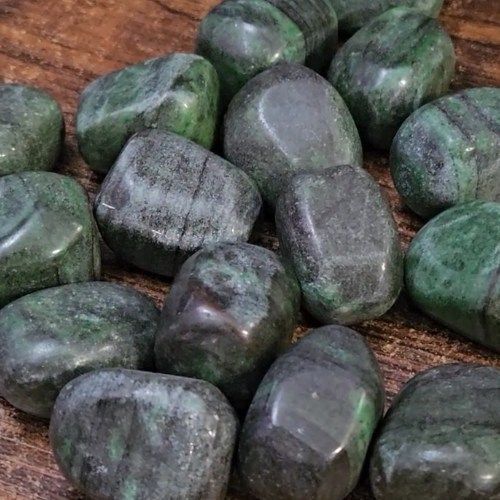SALE! Black Friday, Small Business Saturday and Cyber Monday Event Save 25% off everything! 11-28 to 12-1
Jade Green Dark Tumbled Stones 1"-1.25"
SKU 70590
$3.99
In stock: 1 available
1
Product Details
Jade Green Dark Tumbled Stones 1"-1.25"
Mineral Information:
Jade is a general term that refers to two distinct minerals: jadeite and nephrite. These minerals are highly valued for their beauty and cultural significance. Here is a brief overview of each type of jade:
-
Jadeite: Jadeite is the rarer and more precious type of jade. It is a sodium and aluminum-rich pyroxene mineral. Jadeite is known for its vibrant colors, including green, lavender, white, yellow, and even rare colors like red and blue. It is typically translucent to opaque and can exhibit a glassy luster. Jadeite is highly valued in East Asian cultures, particularly in Chinese and Burmese traditions.
-
Nephrite: Nephrite is the more common type of jade. It is a calcium and magnesium-rich amphibole mineral, specifically tremolite-actinolite. Nephrite is often found in shades of green, ranging from light to dark green, but it can also occur in white, yellow, brown, or black. Nephrite has a fibrous and interlocking crystal structure, giving it strength and durability. It has been valued by various cultures worldwide, including Chinese, Maori, and Mesoamerican civilizations.
Jade has a long history of cultural significance and symbolism. It has been revered as a symbol of purity, wisdom, and harmony. Jade is associated with qualities such as protection, good fortune, and spiritual growth. It has been used to create intricate carvings, jewelry, and ornamental objects for thousands of years.
Metaphysical Meaning:
Jade has a long history of cultural significance and symbolism. It has been revered as a symbol of purity, wisdom, and harmony. Jade is associated with qualities such as protection, good fortune, and spiritual growth. It has been used to create intricate carvings, jewelry, and ornamental objects for thousands of years.
Mineral Care:
Jade, both jadeite and nephrite, is generally considered to be a tough and durable gemstone. It is known for its hardness and resistance to breakage compared to many other gemstones. However, while jade is relatively durable, it is not completely impervious to damage and does have a level of fragility that should be taken into account.
One aspect to consider is that jade is not as hard as some other gemstones. Jadeite has a hardness of approximately 6.5 to 7 on the Mohs scale, while nephrite has a hardness of around 6 to 6.5. While these hardness levels are relatively high, jade can still be scratched by materials with higher hardness, such as corundum or diamond. It is advisable to avoid contact with harder substances and store jade separately from other gemstones or materials that may cause scratches or abrasions.
Another factor to consider is that jade can be vulnerable to fracturing or chipping if subjected to strong impacts or excessive force. Although it is a tough material, jade can have natural flaws, fractures, or weak points within the stone that can make it more susceptible to breakage. It is important to handle jade with care, avoiding dropping or striking it against hard surfaces.
Furthermore, thermal shocks or sudden temperature changes can pose a risk to jade. Extreme temperature variations can cause thermal stress and potentially lead to cracks or breakage. It is advisable to avoid exposing jade to rapid temperature fluctuations, such as placing it in boiling water or exposing it to extreme cold.
To minimize the risk of damage to jade, it is recommended to handle it gently, store it properly, and clean it using mild cleaning agents.
Disclaimer:
No information here is intended to diagnose, treat or cure ailments or afflictions of any kind. One should always consult a medical professional if a serious issue presents itself.
Save this product for later
Jade Green Dark Tumbled Stones 1"-1.25"
Display prices in:USD

